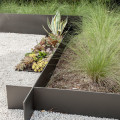Stucco Walls
A stucco wall is any wall built from any number of raw materials that is then covered with stucco.
Stucco is made by mixing an aggregate, a binder, and water together into a compound that is then applied, while wet, to the surface of the wall. This material then hardens into a dense solid that creates a strong, decorative façade.
Stucco is commonly applied to surfaces that lack aesthetic appeal, such as basic concrete, cinder blocks, plain brick, and metal.
One of the greatest benefits of this type of wall is the weather resistance it features. It is durable and attractive and will add curb appeal on both a functional and an aesthetic level.
We can see this in two very common types of stucco walls that are commonly built for Houston residents. One of these is the retaining wall. Adding stucco to the façade of a retaining wall is often done to match the color of the home and other hardscape designs on the property. It also adds additional decorative support to flower beds or small gardens planted in the backfill itself.
The use of stucco is also an ingenious method of creating a seat wall with a back support.
The typical seat wall has only a seating surface, just like the top of a wall. However, if we build a slightly taller wall adjacent to the seat wall and cover them both in stucco, you end up with a wall that works more like a bench with a back rest.
In terms of base materials, retaining walls and seat walls can be built out of virtually anything.
This is an important point for homeowners looking to save costs. The actual wall can be constructed out of something relatively inexpensive, and then covered with a fine stucco finish to form a superb façade. Examples of base materials include wood, concrete, simple stone, natural rock, or even plastic.
The walls themselves can be built out of practically anything.
Stucco walls provide ideal adornment to several different varieties of landscape design.
Tropical landscape design, in particular, can be significantly developed with a series of walls and garden trellises which vines can spread over and cover. The reflected heat and light that emanates off the stucco surface is perfect for tropical plants such as trumpet vine and bougainvillea, which is a beautiful flowering vine.
Stucco walls go hand-in-glove with Mediterranean landscapes and garden design.
We have all seen pictures of Spanish, Italian, and Greek coastal homes whose outer walls and courtyards are covered with stucco. Adding similar structural elements to a home on the Houston landscape helps bring that Mediterranean sensibility straight to the Gulf Coast.
Due to the reflected light and heat that it emanates, stucco is ideal for plants in vegetable garden built with professional irrigation.
Chili peppers, for example, will grow up to six feet tall next to such a wall. It is important that such a garden is well-watered so the plants will get the most from the light and the heat.
Stucco walls are also integral to Spanish garden design.
Outer walls in these gardens can be built to create courtyards of cypress plantings that are sheltered from the world. Inside the courtyard, smaller walls subdivide the garden into zones of interest. Vines are trained to cover wall interiors to add a further sense of private retreat to the moment.


